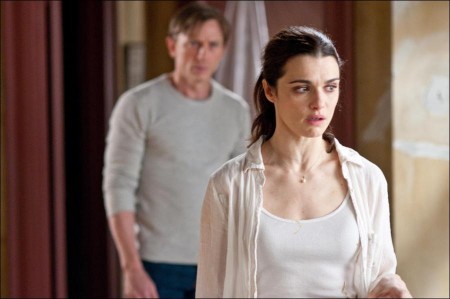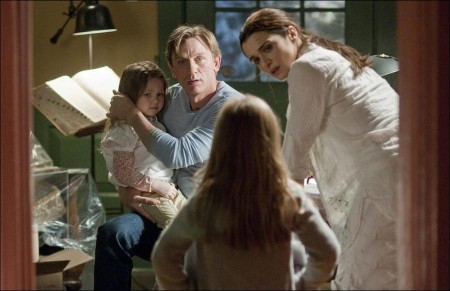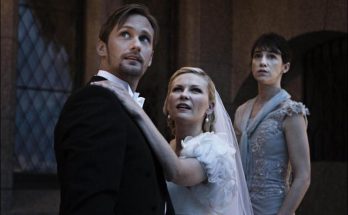Dream House tells the story of a successful publisher (Daniel Craig) who quits a job in New York City to relocate his wife (Rachel Weisz) and two daughters to a quaint New England town. But as they settle into their new life, they discover their perfect home was the murder scene of a mother and her two children. And the entire city believes it was at the hands of the husband who survived.
When Will investigates the tragedy, his only lead comes from a neighbor (Naomi Watts) who was close to the family that died. As Will and Ann piece together the disturbing puzzle, they discover that the story of the last man to leave Will’s dream house will be just as horrifying to the one who came next.
Who Is Peter Ward?
In 2009, production partners Daniel Bobker and Ehren Kruger brought Morgan Creek CEO James G. Robinson and vice president David Robinson the script for Dream House. Bobker and Kruger, who had previously collaborated on the supernatural thriller The Skeleton Key and the action-adventure The Brothers Grimm, were intrigued by the themes that screenwriter David Loucka explored in his psychological thriller and were convinced that Morgan Creek was the right production partner to develop and finance the project.
Loucka wove the fascinating tale of Will Atenton, an accomplished publisher who leaves a hectic job in New York City to spend time with his wife and two young girls in their New England home. Just as he settles in to begin his new career as a writer, Will’s family is plagued by a series of disturbing occurrences in their house. Now, he is forced to confront the fact that nothing is as it seems.
James G. Robinson explains his decision to develop and produce the material: “With so many thrillers, it becomes painfully obvious early on what the twist is, and the director spends the majority of the time trying to cover his or her tracks. What set Dream House apart is that it explores the mystery as it happens from one person’s perspective. As Will tries to figure out who killed the family—or if anyone actually did—there is self-doubt and self-accusation. We loved that you can project your own thoughts onto the material. As it unfolds, the audience will question their own assumptions about what is happening.”
To bring life to the multilayered story, the producers recruited Oscar ®-nominated director Jim Sheridan. The Irish filmmaker, known for an impressive body of work that spans collaborations with Daniel Day-Lewis—My Left Foot, In the Name of the Father and The Boxer—to the deeply personal In America and war drama Brothers, never expected that his next film would be a psychological thriller. Still, he was drawn to the taut material and was impressed by the author’s ability to deftly traverse genres and to keep the reader guessing.
Sheridan acknowledges that he relished the opportunity of helming Dream House. He says: “I read the script, and I quite liked the compelling idea of a guy living in two realities at the same time.” The director was keen to shepherd this “psychological thriller where you don’t know where you are at any point. You don’t know what’s real or who did the murder. In fact, you don’t know if there was a murder at all.”
The filmmaker appreciated that Loucka’s story allowed the reader to intimately enter Will’s mind and to explore our deepest fears of losing our family. He notes, “I think a lot of the time people react to tragedy by inventing fantasy worlds. I suppose, at its basis, drama is a kind of belief system invented by human beings to counter the overwhelming reality of death.”
When considering what would become his approach to the material, Sheridan explains: “You’re trying to capture emotions. You’re trying to capture the invisible: a world that you don’t quite see, but rather feel. I wasn’t that interested in just doing a visual change. I wanted to get an emotional change that’s at the core of Will—a change that comes from the inside out, rather than the outside in.”
As preproduction began, Sheridan began to assemble his top-notch behind-the-scenes team to create Dream House. As well, he cast the actors to play the characters who lived in and around Will’s dream house. In doing so, he looked to a man known for his work in the action and dramatic worlds, as well as a veteran of thrillers and an accomplished Academy Award ® winner.
Dream House – Rachel Weisz
Belongs to the House
When the team was looking for its Will Atenton, a character Sheridan describes as a man who “discovers truths about himself that he didn’t know,” the search ended after Daniel Craig agreed to take on the role. Explains Sheridan of their choice: “Daniel is the kind of guy that women feel would protect them. He seems like a decent sort, and the funny thing is that he is a decent sort. He’s sweet to work with and very straight up.”
Long a fan of Sheridan’s dramatic films, Craig admits he wasn’t a hard sell when the opportunity to work with the director arose. He says: “ I’ve been a fan of his for a long time, and we’d been talking about doing something together for the past couple of years. This came up, and he contacted me, so I said, ‘Let’s do it.’”
As he read Loucka’s screenplay, Craig was drawn to the difficulties that Will faces as he tries to understand the crisis. The actor agrees with Sheridan and appreciates how much of the screenplay leaves the reader uncertain or guessing. He says: “ If you happen to believe in ghosts then, yes, this is a ghost story. If you don’t believe in ghosts, then it’s something that the mind created, which is just as wonderful. We didn’t want to push it either way. We wanted to lea ve it up to the viewer to decide.”
Craig understood that he actually would be portraying two characters in Dream House. He explains Will’s backstory: “I play a happy husband who lives in a dream house with his wife and their two children, and suddenly this other story starts to happen. They find out there’s been a murder in the house. With the previous occupants, the wife and children were murdered, and this story begins to creep into their everyday life. It’s almost like they are being haunted by the house.”
The actor found that playing such a conflicted character was more challenging than he initially expected: “It’s very tricky to do. We did a lot of the film in chronological order and shot the beginning of the movie very early on. The heavier stuff came toward the end. It was very tough emotionally, but as an actor, very satisfying.”
Actress Naomi Watts was cast to play Will and Libby’s next-door neighbor, Ann Patterson. We are introduced to Ann when Will heads across the street to discuss her daughter. We see that Ann is extremely wary of this new neighbor, and she quickly ends the conversation. Sheridan discusses his thoughts on casting the Oscar ® nominee and how she mastered the role of Ann: “Naomi is great with her eyes. She’s just so accurate, and you can read whatever she’s thinking all the time. From the moment you see her in this film, you know there’s something strange about Ann.”
From The Ring series to Eastern Promises and Funny Games, the performer has long been able to share with the audience her characters’ unease by providing a simple look or making the smallest gesture. For Watts, the draw of Dream House was learning how these “three strong characters were very enmeshed in each other’s lives.”
Watts introduces us to her character: “Ann has an ex-husband who she is not on great terms with, and they share a child and there are many issues there. We’re trying to work out what’s going on there with Ann’s family life and if she needs Will’s help or Will needs hers. There are all these big question marks in the film.”
It wasn’t just the chance to work with director Sheridan and with friends Daniel Craig and Rachel Weisz that brought her to the project. The actress admits: “Ann reminded me of a Hitchcock character. There’s something strange about her, something that pulls you in. Audiences will ask, ‘Do we like her, or do we not?’ I liked that juxtaposition, and as an actor, playing out this type of mystery is always fun.”
Oscar ® winner Rachel Weisz, impressed by the script’s deft handling of romance, supernatural and horror, was brought on to the project as Will’s troubled wife, Libby. It wasn’t just the screenplay, but also t he chance to work with talented fellow performers, that drew her to the project. She notes: “Daniel and Naomi were both on board when I signed on, so it couldn’t really have been a more attractive package.”
Reflecting upon her leading man, Weisz says: “Daniel’s character has gone through a lot of pain and is on the edge.” Of her character’s next-door neighbor, she offers: “Throughout the film, Ann knows a secret about Will’s identity and the truth of the murders—the story that the audience doesn’t know. For this role you need an actress who can portray a lot of sensitivity and complexity. You sense that there is a secret and something troubling her, but she can’t say what. Naomi portrays that with great delicacy. She’s got a lot of complexity and is the kind of actress where you can see things flit across her face without needing dialogue.”
Discussing the production’s Libby, Sheridan notes: “Rachel is a gorgeous girl and very passionate about what she does. Her part got bigger as I was making the movie because I realized I had to have her in scenes that she wasn’t written in. I was putting her into a number of scenes, and she would ad-lib certain lines to see what happened.”
Craig shares his take on how this improvisational style of filmmaking worked on the set: “You have a script, and it’s a firm outline to what you’re doing. And you shoot what’s in the script, but then try and discover as much as you can. You don’t leave a scene without eking out of it as much emotion and as much truth you possibly can. It’s writing on the fly as opposed to improvising.”
Two of the youngest members of the cast hold the biggest secrets to the film. Brought on to play the daughters of Will and Libby were sisters TAYLOR GEARE and CLAIRE GEARE. The girls portray, respectively, Trish and Dee Dee, and were most recently seen in the blockbuster Inception. Craig comments on their part in this production: “Just as he did with In America, Sheridan found two children who were perfect for the role. He always tries to find the most natural, most realistic children he can. He doesn’t get performances, he just tries to get them to act as real as possible. They were just stunning.”
As the audience learns the fates of Trish and Dee Dee, the girls show the fear that the audience is feeling. Sheridan, who worked with Taylor Geare during Brothers and met her sister, Claire, during that film’s production, notes of working with children: “You don’t have to play games with them; it’s either real for them, or it’s not. It’s either 100 percent or a zero. There’s no in-between.”
The supporting cast of Dream House includes Marton Csokas as Ann’s ex-husband, Jack; Elias Koteas as the mysterious stranger Boyce; Jane Alexander as Greenhaven’s Dr. Greeley; RACHEL FOX as Ann and Jack’s daughter, Chloe; JOE PINGUE as the former occupant of Peter Ward’s halfway house, Martin; RACHEL CRAWFORD as Ellen Bewes; BRIAN MURRAY as Dr. Medlin; and SARAH GADON and GREGORY SMITH as two neighborhood teens who are terrified by the story of Peter Ward, Cindi and Artie.
James G. Robinson remarks that, to a person, the supporting cast provides the audience with an outlet to share their fear. He remarks, “We are introduced to the people in Will and Libby’s world. As each tells their story, the pieces of the puzzle come together, and we begin to understand who this family is and what actually happened to them. I couldn’t be more pleased with the performances our actors gave, as well as the fear they’re able to elicit.”
Life in Two Worlds
When he envisioned how his team would bring to life Loucka’s script, Sheridan knew that he would have to differentiate the two worlds. He says: “One is of a dream house, and the second is a derelict house with everything decrepit. In movies, it can be difficult to see change in two-dimensional space. A lot of the time the audience won’t notice if you just change a background.”
To compensate for that issue, Sheridan felt “changes in an environment have to be conveyed in a three-dimensional way, like showing someone falling through the floor or putting your hand through a wall or seeing something hanging. We designed the sets in a way that it becomes very obvious in the backgrounds that the house has become decrepit. For example, in one shot, Will comes back and the house is boarded up.” It would be up to cinematographer Caleb Deschanel to expertly lens the vision created by production designer Carol Spier.
Spier, who rejoins her Eastern Promises star Naomi Watts in this film, returned to her Silent Hill and Blade II roots for inspiration. On the overall look of the house, she shares: “I’ve made it look as realistic as possible, even though some of it is refracted through Will’s imagination. At the beginning, I made the house look comfortable and homey, like it was a historical home that Will and Libby wanted to restore. The derelict stage of the house is a bit over the top because you have to make it a little more than it would actually be…but also make it as real as possible.”
Deschanel agrees with Spier’s assessment of an initial delicate touch: “We’ve made the differences simple, with lighting changes or with mood changes. We haven’t used a lot of special visual effects where you spin around and shoot at something against the green screen and change the backgrounds. This creates a reality that an audience can relate to in a way where they’re not feeling like they’re being fooled. It’s like watching a magic trick where you don’t cut away, where you actually watch the person do it.”
Notes costume designer Delphine White: “My challenge was to create two worlds without it being obvious that one was the real world and the other is imagined. I tried to give the lead actors an ephemeral feel, choosing somewhat diaphanous clothing. Libby’s clothing got darker near the end as Will wondered if she was dead and/or a figment of his imagination.”
As well, makeup department head DONALD MOWAT discusses the impact of Will’s character development. The designer notes: “We came up with some ideas—wigs, facial hair, dirt, blood—a breakdown of makeup that we could play with a bit and see what Daniel was comfortable with. Less is more in makeup and hair; it’s usually the things you don’t notice that we’re looking to come up with. The dark shadows under the eyes, the chapped lips: things that indicate somebody who’s distressed and been through quite a lot.”
Though it was important for Sheridan to limit the amount of special effects used in Dream House, those tools were brought in when needed. Special effects designer SOPHIE VERTIGAN explains the motif in a key sequence: “In the beginning of the film, we have a heavy snowstorm in April with a lot of white snow. As we proceed through the movie and begin to discover what happened, the snow begins to melt away.”
Dream House
Directed by: Jim Sheridan
Starring: Daniel Craig, Rachel Weisz, Naomi Watts, Marton Csokas, Claire Geare, Elias Koteas, Rachel G. Fox, Jane Alexander, Bernadette Quigley, Sarah Gadon
Screenplay by: David Loucka
Production Design by: Carol Spier
Cinematography by: Caleb Deschanel
Film Editing by: Glen Scantlebury, Barbara Tulliver
Costume Design by: Delphine White
Set Decoration by: Peter P. Nicolakakos
Art Direction by: Elinor Rose Galbraith
Music by: John Debney
MPAA Rating: PG-13 for violence, terror, some sexuality and brief strong language.
Studio: Universal Pictures
Release Date: September 30, 2011
Hits: 101






